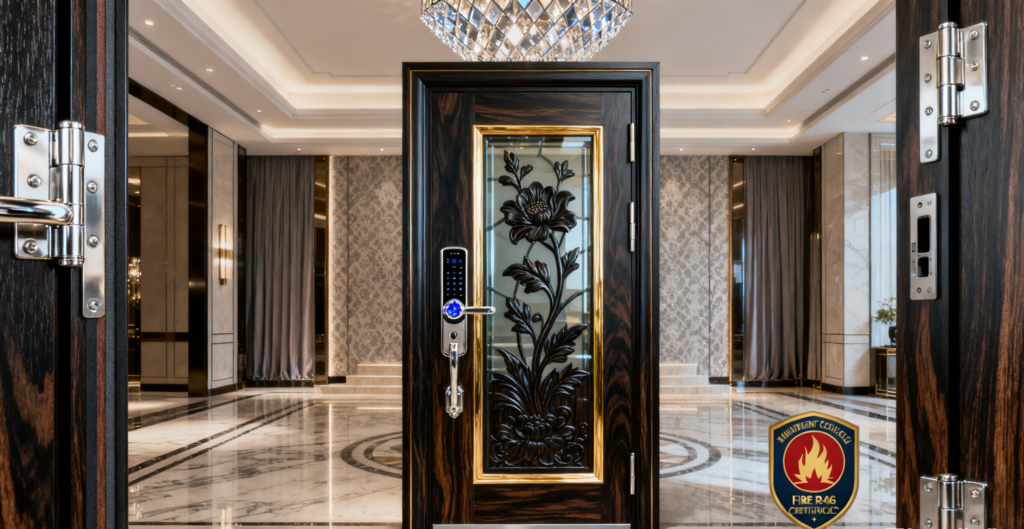Fire-rated doors are essential elements of building safety. Specially engineered to resist fire and smoke for a specified period, these doors help protect lives and property. While many people think of steel or glass doors in fire-rated applications, wood fire-rated doors do exist—and they combine protection with aesthetic appeal.

What Are Fire-Rated Doors?
A fire-rated door is designed to prevent fire and smoke from spreading between compartments of a building. Each is tested under controlled conditions and assigned a fire resistance rating—commonly 20, 60, 90, or 120 minutes. In addition to structural integrity, quality fire-rated doors use smoke seals and intumescent strips to block smoke passage.
Fire-rated doors are required by building codes in many countries. They are installed in corridors, stairwells, elevator lobbies, between fire zones, and in other high-risk areas.
Can There Be Wood Fire-Rated Doors?
Yes—wood fire-rated doors are real and certified. To meet fire safety standards, a wood door must use a specially engineered core (such as mineral core, composite core, or other fire-resistant core materials) and employ fire-rated hardware, seals, and frames. With proper design and testing, wood doors can achieve ratings of 20, 60, or 90 minutes—or even more in certain jurisdictions.
Standard solid wood doors do not qualify; only those manufactured and tested as fire-rated are suitable for fire-resistance purposes.
How Do Wood Fire Doors Work?
Wood fire doors combine layers of protective materials within their structure:
Core Material: Fire-resistant cores like mineral fiber or fireboard cores resist heat penetration.
Veneers / Face Layers: Layers of solid wood veneer or fire-rated MDF give appearance while protecting the core.
Intumescent Seals & Smoke Strips: These expand during high heat to seal gaps and prevent smoke leakage.
Fire-Rated Frames & Hardware: Hinges, closers, latches, and frames are selected to meet fire standards.
During a fire, the core and seals slow heat and flame passage. The wood layers help maintain appearance and structural strength.
Benefits & Considerations
Pros of Wood Fire-Rated Doors
Aesthetic Warmth: Wood gives a natural, elegant appearance not matched by steel or aluminum.
Customization: Stains, species, trims, and decorative details can be tailored.
Sound Insulation: Wood inherently offers better acoustic dampening than metal.
Challenges / Trade-offs
Maintenance: Wood doors require refinishing, sealing, and humidity control.
Moisture Sensitivity: In humid or damp environments, wood may warp or degrade—proper design and sealing is critical.
Wood vs. Steel Fire Rated Doors
Steel tends to offer higher fire resistance in extreme heat and lower maintenance.
Wood excels in design flexibility and interior aesthetics.
The right choice depends on building function, climate, and desired look.
Testing, Certification & Compliance
Wood fire doors are tested according to standards like UL 10B/10C, ASTM E-152, or local equivalents. These tests expose doors to intense heat, pressure, and smoke to determine their fire rating. A certified label or marking must be visible. After installation, regular inspections and maintenance ensure continued compliance.
Maintenance & Inspection
To keep a wood fire door effective:
Inspect for cracks, warps, and damage
Check that seals and intumescent strips are intact
Verify self-closing and latching mechanisms
Ensure the door aligns properly and closes fully
Refinish or reseal wood surfaces regularly
If any damage or deterioration is found, have a qualified fire door technician assess and repair.
Conclusion
Wood fire-rated doors are a compelling solution where both safety and aesthetics matter. When properly manufactured, certified, and maintained, they offer reliable protection while enhancing the design of your interiors. Whether in homes, hotels, offices, or commercial settings, a well-chosen wood fire door delivers both beauty and peace of mind.
📲 Click here for catalogs, styles & pricing: https://wa.me/8613827710205
